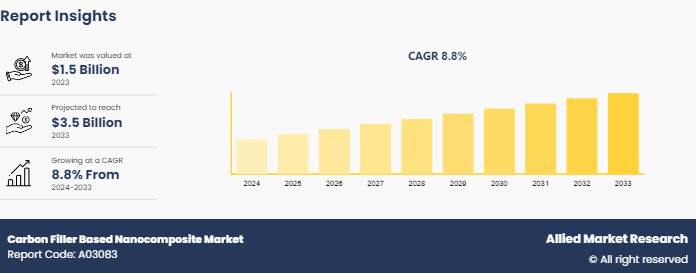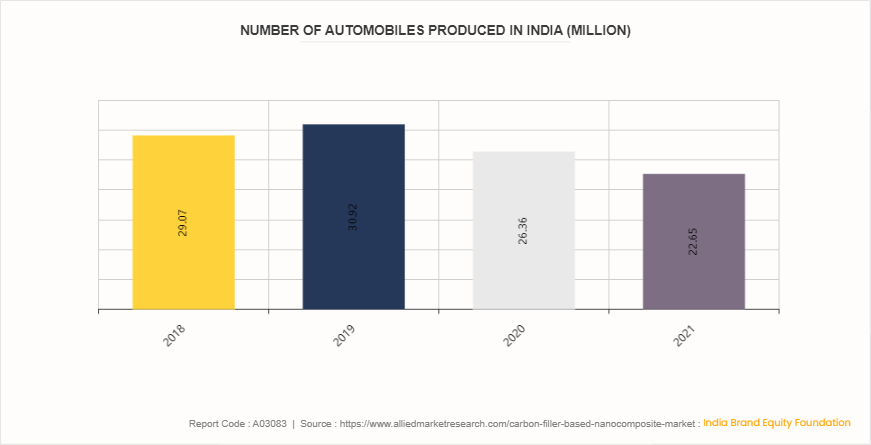Carbon Filler Based Nanocomposite Market Research, 2033
The global carbon filler based nanocomposite market size was valued at $1.5 billion in 2023, and is projected to reach $3.5 billion by 2033, growing at a CAGR of 8.8% from 2024 to 2033.

Market Introduction and Definition
Carbon filler-based nanomaterials include single and multi-walled carbon nanotubes, nanofilms, and carbon nanoparticles, which are currently one of the most attractive nanomaterials. These carbon filler-based nanomaterials have found larger applications in industries where light weight and stiffness are a part of strategical planning such as automotive, electronics, and aerospace. Their exceptional electrical and mechanical properties have potential for future application in various industries such as automotive, aerospace, energy, construction, electronics, and others.
Carbon filler-based nanomaterials are widely used across various industries due to their exceptional properties. In the automotive sector, they enhance the mechanical strength and thermal conductivity of composites, improving performance and durability. In electronics, they are utilized in conductive inks and energy storage devices, such as batteries and supercapacitors, to boost efficiency. In addition, in the construction industry, these materials are integrated into concrete to enhance tensile strength and reduce weight. Their applications extend to medical fields as well, where they are used in drug delivery systems and biocompatible materials.
Key Takeaways
- Over 1,500 product literatures, industry releases, annual reports, and various documents from major carbon filler-based nanocomposite market participants, along with credible industry journals, trade association releases, and government websites, have been reviewed to generate valuable industry insights.
- The carbon filler-based nanocomposite market study covers 20 countries. The research includes a segment analysis of each country in terms of value and volume for the projected period.
- The study integrated high-quality data, expert opinions and analysis, and crucial independent perspectives. This research approach aims to provide a balanced view of global markets and carbon filler-based nanocomposite market overview, assisting stakeholders in making informed decisions to achieve their most ambitious growth objectives.
- Carbon filler-based nanocomposite market news and key industry trends are also included in the report.
Market Dynamics
The carbon filler-based nanocomposites market expansion is driven by the increasing demand for lightweight and high-performance materials in industries such as automotive, aerospace, and electronics, along with their superior mechanical and electrical properties and the growing electronics and semiconductor sectors. The properties of carbon filler-based nanocomposites, such as extremely high tensile strength, excellent flexibility, and superior mechanical and thermal characteristics, make them ideal for various automotive components. According to the International Organization of Motor Vehicle Manufacturers (OICA) , the production of heavy-duty vehicles in Europe reached 308, 300 units in 2021, marking a 31% increase from 236, 328 units in 2020.
Furthermore, the total automobile production in 2021 increased by 25% in Europe, 17% in America, 28% in Asia, and 37% in Africa compared to 2020. Consequently, the rise in global automotive production is expected to boost the demand for carbon filler-based nanocomposites for various automobile components, thereby driving market growth in the coming years. However, high production costs, technical challenges in material dispersion and compatibility, and health and safety concerns pose significant restraints. Opportunities arise from advancements in manufacturing technologies, the expansion of emerging markets, the development of new applications through ongoing R&D, and the trend toward sustainable and eco-friendly materials.
Market Segmentation
The carbon filler-based nanocomposite market is segmented on the basis of carbon filler type, end use, and region. By carbon filler type, the market is classified into carbon nanotubes (CNTs) , graphene, and others. By end use, the market is divided into automotive & transportation, aerospace & defense, electronics & semiconductors, energy & power, construction, and others. Region-wise the carbon filler-based nanocomposite market share is studied across areas such as North America, Europe, Asia-Pacific, and LAMEA.
Regional/Country Market Outlook
The demand for carbon filler-based nanocomposites in North America, particularly in the U.S., is experiencing significant growth. This demand is primarily driven by the automotive and aerospace industries, which seek lightweight, high-strength materials to enhance fuel efficiency and performance. The expanding electronics and semiconductor sectors also contribute to this demand, utilizing the superior electrical conductivity and thermal management properties of nanocomposites. In addition, the renewable energy sector benefits from these materials in the production of durable and efficient components for wind and solar power systems. The U.S.'s strong focus on research and development, coupled with supportive government policies and investments in nanotechnology, further fuels market growth. As sustainability and environmental regulations become more stringent, the adoption of eco-friendly nanocomposites is expected to rise, bolstering their demand across various industries in North America.
Competitive Landscape
Key players in the carbon filler-based nanocomposite market include 3M, Cybershield, Inc., Parker Chomerics, Dow Chemical Company, Schaffner Holding AG, EIS Fabrico, Schlegel EMI, PPG Industries (UK) Limited, Orion Industries Incorporated, and Tech-Etch, Inc.
Automotive Industry Facts
China remains the largest vehicle market globally in terms of both annual sales and manufacturing output, with domestic production projected to reach 35 million vehicles by 2025. According to the Ministry of Industry and Information Technology, over 26 million vehicles were sold in 2021, comprising 21.48 million passenger vehicles—a 7.1% increase from 2020.
Further, the Indian passenger car market was valued at approximately $32.70 billion in 2021 and is projected to reach $54.84 billion by 2027, achieving a CAGR of over 9% from 2022 to 2027. Meanwhile, the global electric vehicle (EV) market, estimated at around $250 billion in 2021, is expected to grow fivefold by 2028, reaching $1, 318 billion. In April 2024, the production of passenger vehicles, three-wheelers, two-wheelers, and quadricycles totaled 2, 358, 041 units. For the fiscal year 2024, the overall production across passenger vehicles, commercial vehicles, three-wheelers, two-wheelers, and quadricycles reached 28, 434, 742 units.

Public Policies
- The Environmental Protection Agency (EPA) , Occupational Safety and Health Administration (OSHA) , and the Food and Drug Administration (FDA) are key agencies regulating nanomaterials.
- The European Chemicals Agency (ECHA) oversees regulations under REACH (Registration, Evaluation, Authorization, and Restriction of Chemicals) and CLP (Classification, Labeling, and Packaging) regulations.
- Organizations such as the International Organization for Standardization (ISO) and the Organization for Economic Co-operation and Development (OECD) develop international standards and guidelines for nanomaterials.
Key Industry Trends
- The aerospace industry is a leading adopter of advanced composite materials, especially those reinforced with carbon fiber. This sector requires lightweight materials that offer high strength and stiffness, along with the capability to mold composite parts and components into curved and complex shapes, which is crucial for military applications. Since their introduction, composites have made up an average of 25% of an aircraft's weight. Recent advancements in aircraft design, exemplified by the Bombardier C-series, Airbus A380, and Boeing B787 airliners, have significantly increased the use of composites. This, in turn, has led to a notable rise in adhesive bonding of primary structures in aircraft.
- There is significant interest in developing polymeric nanocomposites with ultra-high thermal conductivities using materials such as exfoliated graphite or carbon nanotubes. These materials have experimentally measured thermal conductivities of 3, 000 W/mK and theoretical predictions as high as 6, 600 W/mK. However, when added to polymers, the expected enhancement in thermal conductivity is often not achieved due to poor interfacial thermal transfer. In 2020, NASA Langley Research Center developed a method for creating highly thermally conductive polymeric composites. These materials are valuable for applications requiring efficient, lightweight, and flexible thermal management solutions, such as liquid-cooled ventilation garments. This technology involves forming carbon-based fillers for incorporation into nanocomposite materials with high thermal conductivity. The process includes treating expanded graphite with an alcohol/water mixture, followed by further exfoliation to create extremely thin carbon nanosheets, approximately 2 to 10 nanometers thick. These carbon nanosheets can be functionalized and used as fillers in polymer nanocomposites to achieve exceptionally high thermal conductivities.
Key Sources Referred
- National Nanotechnology Initiative (NNI)
- European Commission - Horizon Europe
- Japan's Ministry of Economy, Trade, and Industry
- National Science Foundation (NSF)
- Frontiers Media S.A.
- National Institute of Advanced Industrial Science and Technology (AIST)
- Department of Science and Technology (DST)
Key Benefits For Stakeholders
- This report provides a quantitative analysis of the market segments, current trends, estimations, and dynamics of the carbon filler based nanocomposite market analysis from 2024 to 2033 to identify the prevailing carbon filler based nanocomposite market opportunities.
- The market research is offered along with information related to key drivers, restraints, and opportunities.
- Porter's five forces analysis highlights the potency of buyers and suppliers to enable stakeholders make profit-oriented business decisions and strengthen their supplier-buyer network.
- In-depth analysis of the carbon filler based nanocomposite market segmentation assists to determine the prevailing market opportunities.
- Major countries in each region are mapped according to their revenue contribution to the global market.
- Market player positioning facilitates benchmarking and provides a clear understanding of the present position of the market players.
- The report includes the analysis of the regional as well as global carbon filler based nanocomposite market trends, key players, market segments, application areas, and market growth strategies.
Carbon Filler Based Nanocomposite Market Report Highlights
| Aspects | Details |
| Market Size By 2033 | USD 3.5 Billion |
| Growth Rate | CAGR of 8.8% |
| Forecast period | 2024 - 2033 |
| Report Pages | 250 |
| By Carbon Filler Type |
|
| By End Use |
|
| By Region |
|
| Key Market Players | PPG Industries (UK) Limited, Schlegel EMI, Cybershield, Inc., EIS Fabrico, Parker Chomerics, Dow Chemical Company, Tech-Etch, Inc., 3M, Schaffner Holding AG, Orion Industries Incorporated |
The carbon filler-based nanomaterials market growth is driven by an increase in demand for lightweight and high-performance materials in industries such as automotive, electronics, and construction.
Automotive and transportation is the leading application of Carbon Filler Based Nanocomposite Market.
Asia-Pacific segment held the highest market share in 2023.
The carbon filler based nanocomposite market was valued at $1.5 billion in 2023, and is estimated to reach $3.5 billion by 2033, growing at a CAGR of 8.8% from 2024 to 2033.
Key players in the carbon filler-based nanocomposite market include 3M, Cybershield, Inc., Parker Chomerics, Dow Chemical Company, Schaffner Holding AG, EIS Fabrico, Schlegel EMI, PPG Industries (UK) Limited, Orion Industries Incorporated, and Tech-Etch, Inc.
Loading Table Of Content...


